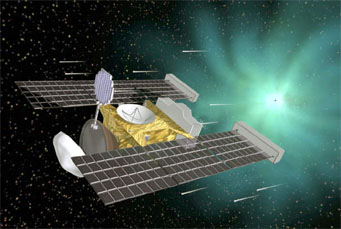NASA's Stardust mission has just reminded us — for the second time — that we don't know as much about comets as we thought we did.
Comets are thought to be nearly unaltered relics from the formation of the solar system, and Stardust's target, 81P/Wild 2 (pronounced vilt) was considered a perfect target. These days Wild 2 can venture fairly near the Sun (just beyond Mars's orbit). But prior to a close brush with Jupiter in 1974, its orbit was much more distant.

NASA's Stardust dashed through the dusty coma of Comet Wild 2 on January 2, 2004, and returned the tiny samples it collected to Earth on January 15, 2006.
NASA / JPL
So cosmochemists would have bet money (and maybe did) that the dust and gas coming off Wild 2 when Stardust flew through it in 2004 would be primordial building blocks, released from their deep-freeze confinement after 4½ billion years, that would unlock the key to the solar system's formation.
The smart money, it turns out, was wrong. Not long after Stardust returned to Earth in January 2006 with its precious cargo, it became clear that some of those building blocks came from a very hot kiln. Researchers found an array of minerals that formed at temperatures of at least 2,000°F (1,100°C). Not exactly "deep-freeze" conditions!
Now Stardust has stumped the scientists again. In Science for January 25th, a team led by Hope Ishii (Lawrence Livermore National Laboratory) reports that the captured cometary grains are closer matches to "an inner solar-system asteroid than an outer-solar-system comet with primitive unaltered dust."
In other words, silicate minerals that formed near the Sun were somehow transported to the outer system, where they mingled with ices to create Comet Wild 2. There are no mineral clusters untouched since the Sun first blazed to life, no infusions of exotic isotopes from distant supernovas — if it weren't so dynamically implausible, you might think Comet Wild 2 was an escapee from the asteroid belt.
Did all comets form this way? Probably not. High-flying jets have captured a host of interplanetary dust particles drifting into our atmosphere from space. These tiny treasures have the kind of primitive compositions and unique isotopic mixes that scientists had expected to find in the Stardust samples.
So maybe we just need to go sample another comet (Rosetta, a European-built craft, will do so in 2014). Or maybe our theories of solar-system formation need retooling. Whatver the reason, Stardust has lots of cosmochemists scratching their collective heads right now.
 7
7
Comments
Scott C. Schumacher
January 29, 2008 at 12:34 am
I suspect that this discovery will give a boost to the so-called "X-Wind" theories.
You must be logged in to post a comment.
jim clark
January 30, 2008 at 9:22 am
I have often thought that space between the stars is full of stuff from exploded stars- water comets, iron and rock meters. Sometimes this stuff falls into our solar system- and it has nothing to do with the formation of our solar system. Could swarms of meters exist between the stars and are we between these swarms now?
You must be logged in to post a comment.
jiminboulder
February 1, 2008 at 12:30 pm
....Or maybe we need to stop throwing away hundreds of millions of dollars per shot to keep feeding the military-scientific-industrial complex.
You must be logged in to post a comment.
Tom Fleming
February 2, 2008 at 4:45 am
Agree with J C. This brief article did not provide an apparent reason the silicates didnt hitchhike with primordial materials including some planetary detritus from outside the solar system.
As well, collision processes in our early S S formation were quite violent. It would be possible for some 'comet/asteroids' to be urged in the direction of the Kuiper Belt.
You must be logged in to post a comment.
Darrin
February 2, 2008 at 5:15 pm
I was under the impression that Sol was not a primordial first generation star. If that is indeed the case why shouldn't there be silicates and even heavier elements present in the cloud that coalesced to form the solar system? If the heaviest elements in our solar system came from prior supernovae those minerals could have formed in the shock wave of the explosions slamming into (and perhaps triggering the collapse of) the gas that became the solar system. I have a hard time understanding why anything in the solar system stayed under 2,000K during the collapse into a protoplanetary disk.
You must be logged in to post a comment.
Enricothe Great
February 3, 2008 at 12:36 am
President Eisenhower REALY handed the ncurmudgeons a club they just can't let go of-----how about sitting back and enjoying some stronomy!
You must be logged in to post a comment.
Oliver Manuel
February 27, 2008 at 7:35 pm
http://www.omatumr.com/Origin.htm explains why comets contain the elements that form rocks - iron (Fe), oxygen (O), silicon (Si), nickel (Ni) and sulfur (S).
These same elements are also abundant in interior of the Sun, although its surface is covered with the most lightweight elements - H (91%) and He (9%).
You must be logged in to post a comment.
You must be logged in to post a comment.